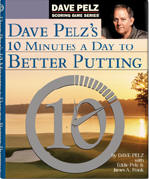Dave Pelz’s 10 Minutes a Day to Better Putting
David Pelz is the mad genius of golf instruction.
It’s easy to see that this is true. Just watch one of Pelz’s televised segments on the Golf Channel, and look carefully at his eyes as he talks directly to the camera.
You can just tell right away that the man’s just a little intense about golf, don’t you think?
I hasten to add the appropriate disclaimer that there’s nothing wrong with that.
A golf instructor’s fanaticism about helping his students learn how to play their best golf in all segments of the game is the right attitude. After all, if he didn’t care so much, why should you?
Pelz’s life work of teaching golfers the hows and whys of the game is widely available, through his Golf Channel appearances, traveling seminars, and now his books.
This most recent edition is dedicated to putting, and the way it was put together shows the influence of his television work.
First, it’s highly visual. Nearly every page is a full-color photograph, with short bursts of contrasting text in the foreground explaining the point being made in the picture at the same time.
Second, the photography is frequently beautiful, but primarily sharp and loaded with special effects. Pelz makes great use of multiple stop-action shots to illustrate his fundamental points about putter aim, alignment, and reading breaks.
Third, the instructions are clear and concise. Those seeking highly detailed explanations for why the golf ball reacts as it does to a putter and a green can read elsewhere about it, such as in Pelz’ longer work, the Putting Bible.
This book is dedicated to a different set of students, who are given a set of guiding principles and techniques in easily digestible segments.
Finally, Pelz makes heavy use of the many props that he also utilizes in his schools and television shows. Those who’ve seen Pelz on TV will see again how his various teaching devices such as the Putting Track® or O-Balls® can help students.
The fact that Pelz also sells these devices is no coincidence, of course, but that’s fine. We are not averse to capitalism.
By the way, Pelz’s suggestions work. I’ve tried several of his suggestions on the putting green and out on the course, and he’s right.
For example, recently I’ve aligned the ball further upslope than I had been, and that one move has helped sink several putts that I’m sure would have otherwise missed on the low side.
Like most instruction books, this is not one to be read straight through. For a short book that is mostly illustrations, there’s a lot here to digest.
I agree with Pelz’s recommendation to read each segment, try his suggestions until you have integrated their facets into your game, and then move to the next chapter.
This book won’t make you as fanatical about golf as Pelz is, if that’s a concern to you.
On the other hand, this newest addition to his Scoring Game Series® will surely help you improve your putting.
Review Date: October 18, 2003


